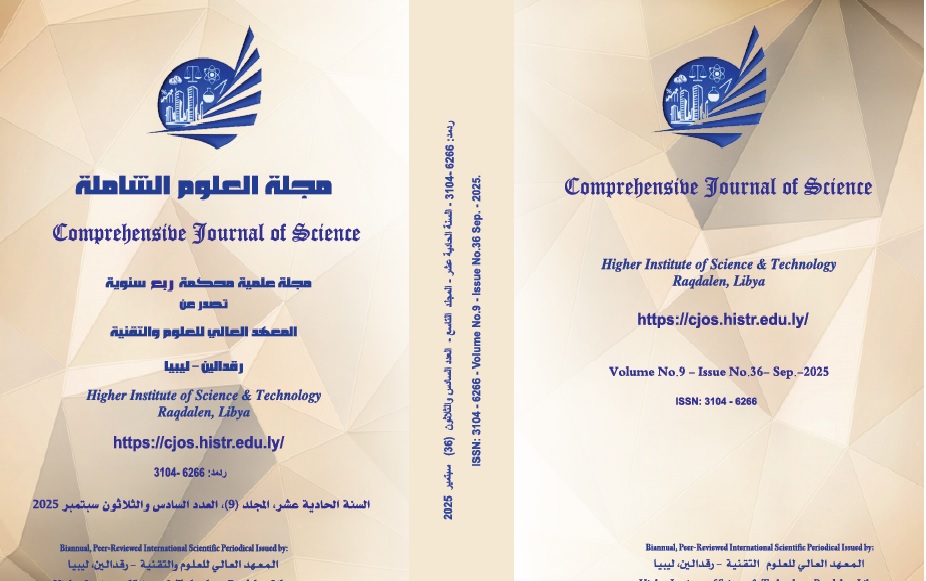دراسة مقارنة لطرق اختيار الميزات للتنبؤ بأمراض القلب القائمة على CatBoost
الكلمات المفتاحية:
الذكاء الاصطناعي، توجيه المكالمات الصوتية، شبكات الجيل الخامسالملخص
تناول هذا البحث استخدام الذكاء الاصطناعي (AI) لتحسين توجيه المكالمات الصوتية عبر شبكات الجيل الخامس والشبكات السلكية. غالبًا ما تفشل أنظمة التوجيه التقليدية في التكيف مع ظروف الشبكة المتغيرة، مما يؤدي إلى ضعف جودة الكلام وارتفاع زمن الوصول وإهدار الموارد. لحل هذه المشكلات، تقدم الورقة نموذجًا لاختيار المسار قائمًا على الذكاء الاصطناعي يستخدم أساليب التعلم الآلي، ولا سيما التعلم التعزيزي، لتحديد مسارات التوجيه المثلى ديناميكيًا بناءً على مقاييس جودة الخدمة (QoS) في الوقت الفعلي مثل زمن الوصول والتذبذب وفقدان الحزم. تم استخدام نهج بحث تجريبي، مع استخدام أدوات محاكاة (مثل NS-3 و OMNET ++) لمحاكاة إعدادات الشبكة الهجينة وتقييم إطار التوجيه المقترح القائم على الذكاء الاصطناعي. أظهرت النتائج أن نموذج الذكاء الاصطناعي عزز بشكل كبير جودة المكالمات الصوتية، وخفض زمن الوصول، وأزال فقدان الحزم، وتفوق في الأداء على أنظمة التوجيه القياسية في ظل إعدادات المحاكاة. وتختتم الورقة باقتراحات عملية لنشر التوجيه القائم على الذكاء الاصطناعي في البنية التحتية للاتصالات في العالم الحقيقي، مع التركيز على قابلية التوسع للنموذج ومرونته ودقة التنبؤ.
التنزيلات
المراجع
[1] Dua, D. and Graff, C. (2019). UCI Machine Learning Repository. Irvine, CA: University of California, School of Information and Computer Science. (http://archive.ics.uci.edu/ml)
[2] Güllü, M., Akeyyol, M. A., & Barşgi, N. (2022). Machine learning-based comparative study for heart disease prediction. Advances in Artificial Intelligence Research (AAIR).
[3] Khemphila, A., & Boonjing, V. (2011). Heart disease classification using neural network and feature selection. International Conference on Systems Engineering.
[4] Raykar, S., & Shet, V. (2021). Comparative analysis of feature selection based machine learning methods for heart disease prediction. ITEE Journal.
[5] Anuradha, P., & David, V. K. (2022). Feature selection by ModifiedBoostARoota and classification by CatBoost model on high dimensional heart disease datasets. International Journal of Computer Theory and Engineering.
[6] Firdaus, F. F., Nugroho, H. A., & Soesanti, I. (2020). A review of feature selection and classification approaches for heart disease prediction. International Journal of Information Technology and Electrical Engineering.
[7] Tibshirani, R. (1996). Regression Shrinkage and Selection via the Lasso. Journal of the Royal Statistical Society. Series B (Methodological).
[8]Alizadehsani, R., Hosseini, M. J., Sani, Z. A., Ghandeharioun, A., & Boghrati, R. (2012). Diagnosis of coronary artery disease using cost-sensitive algorithms. In 2012 IEEE 12th International Conference on Data Mining Workshops (pp. 9-16). IEEE.
[9]Anbarasi, M., Anupriya, E., & Iyengar, N. C. S. N. (2010). Enhanced prediction of heart disease with feature subset selection using genetic algorithm. International Journal of Engineering Science and Technology, 2(10), 5370–5376.
[10] Anuradha, P., & David, V. K. (2022). Feature selection by ModifiedBoostARoota and classification by CatBoost model on high dimensional heart disease datasets. International Journal of Computer Theory and Engineering, 14(4), 141–148. https://doi.org/10.7763/IJCTE.2022.V14.1321
[11] Ayar, M., & Şabanoviç, S. (2018). An ECG-based feature selection and heartbeat classification model using a hybrid heuristic algorithm. Informatics in Medicine Unlocked, 13, 167–175.
[12] Boonjing, V., & Khemphila, A. (2011). Heart disease classification using neural network and feature selection. In 2011 21st International Conference on Systems Engineering (pp. 406-409). IEEE. https://doi.org/10.1109/ICSEng.2011.80
[13] Dahal, K. R., & Gautam, Y. (2020). Argumentative comparative analysis of machine learning on coronary artery disease. Open Journal of Statistics, 10(4), 694–705.
[14] Firdaus, F. F., Nugroho, H. A., & Soesanti, I. (2020). A review of feature selection and classification approaches for heart disease prediction. International Journal of Information Technology and Electrical Engineering, 4(3), 75–82.
[15] Güllü, M., Akeyyol, M. A., & Barşgi, N. (2022). Machine learning-based comparative study for heart disease prediction. Advances in Artificial Intelligence Research (AAIR), 2(2), 51–58. https://doi.org/10.54569/aair.1145616
[16] Kolukisa, B., et al. (2018). Evaluation of classification algorithms, linear discriminant analysis and a new hybrid feature selection methodology for the diagnosis of coronary artery disease. In 2018 IEEE International Conference on Big Data (Big Data) (pp. 2232-2238). IEEE.
[17] Kolukisa, B., et al. (2020). Coronary artery disease diagnosis using optimized adaptive ensemble machine learning algorithm. International Journal of Bioscience, Biochemistry, and Bioinformatics, 10(1), 1–12.
[18] Raykar, S., & Shet, V. (2021). Comparative analysis of feature selection based machine learning methods for heart disease prediction. ITEE Journal of Information Technology & Electrical Engineering, 10(1), 41–48.
التنزيلات
منشور
إصدار
القسم
الرخصة

هذا العمل مرخص بموجب Creative Commons Attribution-NonCommercial-ShareAlike 4.0 International License.











